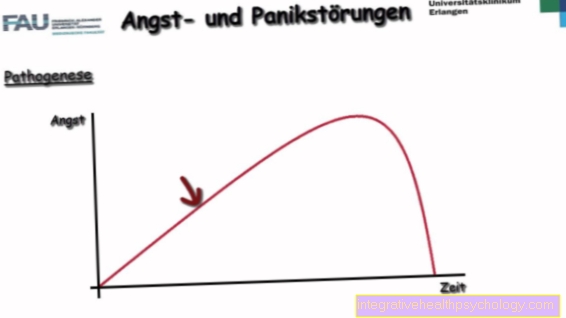Influenza
definition

Influenza, sometimes also called "real“Influenza, or viral flu, describes a disease that can be caused by certain groups of viruses. It is a very contagious disease that should not be confused with other viral diseases, which usually cause a normal cold. The influenza mostly occurs in the cold seasons especially older people and children, as well as people with an immune deficiency or previous illnesses are at risk from the disease.
In the last few years there have been repeated mutations in the viruses known as "swine flu" or "bird flu". There is a vaccine against most relevant types of influenza viruses, which is the only prophylactic protection available against the disease and is usually paid for by statutory and private health insurance companies.
Read more about the topic under flu viruses
Symptoms
An illness with influenza viruses can show symptoms of varying severity. This particularly depends on how the sick person's immune system is coping with the virus. In particular, people with a weak immune system, such as children, the elderly and people who have a weak immune system due to medication or illness, are affected by severe symptoms of influenza. However, people who were completely healthy before the illness and have a healthy immune system can also suffer from the symptoms of influenza. Overall, weak courses of the disease up to severe impairment of the body can occur.
It is difficult to diagnose the disease because the symptoms of influenza virus disease are very non-specific. This means that a disease with such a virus cannot always be recognized as such. However, there are some warning signs that, if interpreted correctly, indicate the presence of real flu. An acute, sudden onset of illness is typical for an illness with the virus. The condition and the symptoms that accompany it can appear within a few hours. A mostly compared to a "normal cold“A longer course and thus a longer period of time in which the symptoms of the disease are noticeable is a further indication that the disease is a“ real flu ”that was triggered by an influenza virus.
The relatively unspecific symptoms, which are usually felt with the disease, are characterized by a high fever (up to 40 ° C), an associated chills, headache and body aches, fatigue, tiredness and a general feeling of illness. The symptoms are usually so severe that they have to interrupt a normal daily rhythm and rest for most of the illness. Other typical symptoms that affect the airways are swelling of the nasal mucous membranes and a dry cough. Symptoms of the gastrointestinal tract include a marked loss of appetite, nausea, vomiting, and the occurrence of severe diarrhea.
In most cases, symptoms of influenza last 7-14 days before they resolve. Since all of the symptoms mentioned can also occur with a normal cold, it is not surprising that these are often referred to as “flu-like infections”. By carrying out a diagnosis from the attending physician, however, a “real flu” can be distinguished from a “flu-like infection”, i.e. a cold, relatively reliably.
Read more on the topic: Superinfection
diagnosis
In the foreground of the diagnosis of the illness with the influenza virus is the doctor-patient conversation in the context of the anamnesis of the sick person. The most important thing here is Inquiry about the immune status of the patient, as the individual risk of the disease can be assessed by the doctor. For example, people with a weakened immune system have a greatly increased risk of complications occurring during the course of influenza. Symptoms, possible previous illnesses, allergies, medication and individual lifestyle habits are also asked about in this conversation.
Another important step in making a diagnosis is the physical exam. Especially when an influenza virus is suspected, the so-called Auscultation of the person concerned. The doctor will listen to the lungs using a stethoscope. Certain noises, which are caused by inhaling or exhaling, can be an indication of the illness with an influenza virus to the attending physician.
Also the Palpation, so palpation of the abdominal organs can give an indication of the patient's situation. In this way, the situation of the gastrointestinal tract in particular can be assessed.
Since these tests confirm the suspicion of illness with the influenza virus, but cannot confirm 100%, a swab of the mucous membranes can be carried out to confirm the presence of the virus. A cotton swab is wiped off the nasal mucosa or the oral mucosa and the material is sent to a laboratory for diagnosis. If there is an illness with the influenza virus, the DNA of the virus is detected in the sample and the diagnosis is confirmed with certainty.
Alternatively, the affected person's blood can be used to make the diagnosis. Especially after 7 days after the flu outbreak, a sufficient amount of it may be in the blood Antibodies that are specific for the presence of the disease and the detection of this thus confirms the disease. Another parameter that can corroborate the suspicion of an illness with influenza viruses is the so-called Blood sedimentation rate (short: BSG or BSR). This value indicates how much time elapses before the cellular components of the blood have largely separated from the non-cellular components of the blood. A positive result, i.e. if this speed is increased, can, however, also speak for the presence of other diseases, which is why this method does not prove very selectively for the presence of an influenza disease.
Much better and more sensitive are a number of rapid tests which, if positive, can detect the influenza virus with great certainty. These rapid tests are particularly popular when the diagnosis based on laboratory results would take too long to start therapy. The principle of these tests is based on an antibody-antigen reaction. It is important to mention that these tests are currently not carried out by the statutory health insurance companies.
Read more about this at: Rapid flu test
therapy

The therapy the sick person takes place entirely depending on the risk profile individually. This means that a different therapy should be recommended to an immunocompromised person than to a person for whom your own immune system is probably strong enough to get the disease under control on your own. Since in the worst case the disease with immunocompromised persons even to death can lead, stands the early start of therapy the disease in these people in the foreground. For people who fall into this group, a antiviral therapy carried out, whereas in people with competent immune systems a so-called symptomatic therapy The focus is on which, although not the cause of the disease, treats the unpleasant complaints that accompany it.
Antiviral therapy: Antiviral therapy combats those responsible for influenza Viruses directly. Depending on when the therapy with these Medication Is started, the duration of the disease can be increased by using this significantly shortened become. This treatment is important for immunocompromised patients, as it has been shown that the number of dangerous complications in patients with influenza viruses and a weakened immune system decreased significantly if antiviral therapy was started early. It exists two different active ingredients, which are suitable for antiviral therapy in the presence of an illness with influenza viruses.On the one hand, there are drugs on the market that inhibit a specific membrane protein that is important for the survival of the virus, as well as the more commonly used so-called Neuraminidase inhibitors.
The Neuraminidase inhibitorsr inhibit, as the name suggests, the so-called Neuraminidase. By inhibiting this enzyme, the virus can no longer detach itself from the host cell and the spread of the virus in the body is thus effectively prevented.
Both drugs available prevent the virus from spreading and multiplyingwhich is why they too Antivirals to be named. The "kill“Of the virus cells that are already in the body must therefore own immune system Afford. Nevertheless, these drugs provide helpful support for the immune system if therapy is started early and can prevent dangerous situations for immunocompromised patients. A beginning of therapy after 48 hours after the first symptoms appear, however, experts consider it not useful believes that after this time there are too many active viruses in the body that the available drugs cannot kill.
Symptomatic therapy: Symptomatic therapy is primarily in the foreground for affected people who are affected by the disease, but otherwise no weakening of the immune system exhibit. Symptomatic therapy is intended to alleviate the symptoms that usually accompany the disease. In contrast to antiviral therapy, symptomatic therapy includes a number different drug optionswhich, depending on the symptoms, have a different profile of effects. So can against head- and Body ache pain relievers how Ibuprofen or Paracetamol which are also given in the treatment of the Fever bouts stand in the foreground. The dose of medication to be taken should however always discussed with the attending physician to prevent overdosing. It is important to know that drugs contain the active ingredient Acetylsalicylic acid included, such as aspirinshould never be given to children under the age of 12. The reason for this is the risk of a dangerous complication, the so-called Reye syndrome.
For the treatment of symptoms that affect the gastrointestinal tract, a number of drugs are available, for example nausea or Diarrhea Can treat symptomatically.
In addition to drug therapy, it is helpful for the body enough liquid feed and sufficient rest for fighting the disease to give.
Other therapy options: Although the flu illness is on Viruses In some cases it can make sense to undergo treatment with a antibiotic initiate. Since the immune system is somewhat weakened by the fight against influenza, so-called Superinfections with bacteriawhich can worsen the symptoms of influenza and worsen the feeling of illness. In addition to the regular symptoms of influenza, this often occurs acute bronchitis, bacterial strep throat, Pneumonia or even Meningitis. When treating these infections, an antibiotic can help the body's immune system and speed up the resolution of the disease and prevent dangerous complications from developing.
prophylaxis
Since the illness with influenza viruses can be not only unpleasant but even very dangerous, it makes sense to avoid the outbreak of the disease itself. The only really effective way to prevent influenza viruses from becoming infected is to vaccinate them against them. However, since certain groups of influenza viruses have a high mutation rate, a new vaccine must be developed at regular intervals that is supposed to be effective against most influenza viruses. The Standing Vaccination Commission (STIKO) has issued a recommendation for the annual refreshment of the flu vaccination for certain risk groups. These risk groups include:
- all persons over 60 years
- all pregnant women who are pregnant in the influenza season
- People who, due to certain previous illnesses, would be at risk from an influenza virus disease
- Residents of old people's or nursing homes
- People who are exposed to a greater risk of becoming ill (e.g. medical staff) or who have an increased risk of infecting other people (e.g. teachers)
- as well as people who are in contact with poultry or wild birds
The costs for the vaccination are usually covered by statutory or private insurance. Everyone has to decide individually how to vaccinate. Vaccination against influenza viruses is not advised against people who do not belong to these risk groups. However, since the immune system of these groups of people is able to fight off the disease on its own in most cases, the urgency of the vaccination is classified as lower. Overall, the data from the Robert Koch Institute show that around 26.6% of the adult population were vaccinated against the influenza virus in the 2009/10 season. The numbers in the individual risk groups are slightly higher, but do not meet the targets set by the European Union, which aims for a vaccination rate of 75% for older people over 60, for example.
Other measures that can prevent illness with influenza viruses include, above all, personal hygiene. In particular, thorough washing and disinfection of the hands several times a day can efficiently prevent infection with the virus. People with an increased risk profile should be particularly careful when they come into contact with sick people and take precautionary measures that can prevent infection. This includes, for example, wearing a face mask.
People who, for various reasons, can no longer be vaccinated against the virus (for example, due to a severely weakened immune system), should be treated with neuraminidase inhibitors as prophylaxis.
Side effects are common after flu vaccinations. Read our article on this: Side effects of the flu shot





























